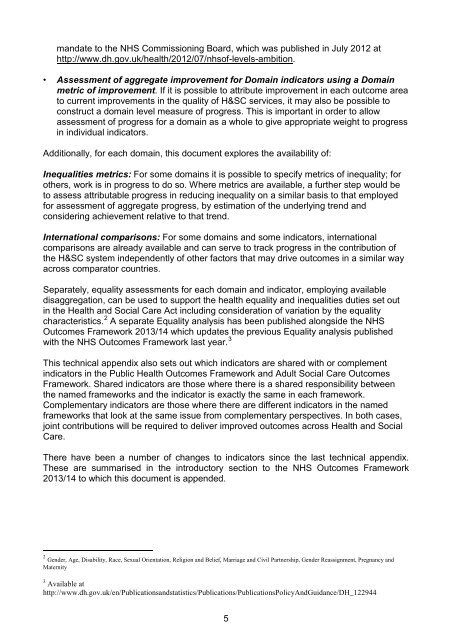IntroductionThis technical appendix sets out the detailed definitions and data sources for each indicator,grouped under the five domains of the <strong>NHS</strong> <strong>Outcomes</strong> <strong>Framework</strong>. Each section has anintroduction that describes the domain, followed by detailed templates for each indicator,including a description of where and when the source data for the indicators are published.Where available, the data for individual indicators have been published on the <strong>NHS</strong>Information Centre Indicator Portal (https://indicators.ic.nhs.<strong>uk</strong>/webview/). This websitecontains not only <strong>NHS</strong> <strong>Outcomes</strong> <strong>Framework</strong> indicators, but wider health and social careindicators, including social care and GP practice data. <strong>The</strong> majority of indicators in the <strong>NHS</strong><strong>Outcomes</strong> <strong>Framework</strong> are now available on this site, with historical time series 1 anddisaggregations. <strong>The</strong> data are in a raw format to allow subsequent analysis. <strong>The</strong> site isupdated regularly with new data as they become available. As new placeholder indicatorsare developed, these will also be added to this site. This technical appendix signals foreach indicator if data are published on the <strong>NHS</strong> IC Indicator Portal, at the time of writing.<strong>The</strong> status of each indicator is shown by the following classification –• Live – Indicator development is complete, and as they becomes available, data areplaced on the Indicator Portal.• In development – Some elements of the indicator definition require furtherdevelopment,• Placeholder – A need to measure this outcome has been identified, and one or morepotential sources have been identified, but an indicator is yet to be developed, andpublication on the portal is not imminent.<strong>The</strong> <strong>Gov</strong>ernment’s Mandate to the <strong>NHS</strong> Commissioning Board asks the Board to makecontinuous progress against all the five domains and the outcome indicators in the <strong>NHS</strong><strong>Outcomes</strong> <strong>Framework</strong>. <strong>The</strong> <strong>NHS</strong> Commissioning Board must report on its progress eachyear, and the <strong>Gov</strong>ernment will publish an annual assessment of the Board’s performance.We will investigate, with the <strong>NHS</strong> Commissioning Board and the <strong>Outcomes</strong> <strong>Framework</strong><strong>Technical</strong> Advisory Group, how we can assess progress at both indicator and domainlevel, for example by:• Estimation of the underlying trend for each indicator as a basis for assessinggains attributable to improvements in the health and social care system.<strong>Outcomes</strong> are shaped both by the current quality of health and social care (H&SC)services and by historic and external determinants. In order to identify what change inoutcomes might be attributable to changes in the quality of H&SC services, methodswill be investigated for the estimation of the trajectory of outcomes that would havebeen expected based upon past developments of H&SC and any contemporary non-H&SC drivers of outcome, were the quality of current H&SC services held constant.This work will enable assessment of progress against individual indicators attributableto changes in the quality of current H&SC services. (For example, where there is anadverse underlying trend in an indicator, abating that trend would represent progressattributable to H&SC.) This analysis could draw upon aspects of the methodologicalwork set out in the <strong>Technical</strong> Annex which accompanied the consultation on the draft1 Trend data are also presented in <strong>NHS</strong> <strong>Outcomes</strong> <strong>Framework</strong>: a technical annex about setting levels of ambitionpublished at http://www.dh.gov.<strong>uk</strong>/health/2012/07/nhsof-levels-ambition/4
mandate to the <strong>NHS</strong> Commissioning Board, which was published in July 2012 athttp://www.dh.gov.<strong>uk</strong>/health/2012/07/nhsof-levels-ambition.• Assessment of aggregate improvement for Domain indicators using a Domainmetric of improvement. If it is possible to attribute improvement in each outcome areato current improvements in the quality of H&SC services, it may also be possible toconstruct a domain level measure of progress. This is important in order to allowassessment of progress for a domain as a whole to give appropriate weight to progressin individual indicators.Additionally, for each domain, this document explores the availability of:Inequalities metrics: For some domains it is possible to specify metrics of inequality; forothers, work is in progress to do so. Where metrics are available, a further step would beto assess attributable progress in reducing inequality on a similar basis to that employedfor assessment of aggregate progress, by estimation of the underlying trend andconsidering achievement relative to that trend.International comparisons: For some domains and some indicators, internationalcomparisons are already available and can serve to track progress in the contribution ofthe H&SC system independently of other factors that may drive outcomes in a similar wayacross comparator countries.Separately, equality assessments for each domain and indicator, employing availabledisaggregation, can be used to support the health equality and inequalities duties set outin the Health and Social Care Act including consideration of variation by the equalitycharacteristics. 2 A separate Equality analysis has been published alongside the <strong>NHS</strong><strong>Outcomes</strong> <strong>Framework</strong> <strong>2013</strong>/<strong>14</strong> which updates the previous Equality analysis publishedwith the <strong>NHS</strong> <strong>Outcomes</strong> <strong>Framework</strong> last year. 3This technical appendix also sets out which indicators are shared with or complementindicators in the Public Health <strong>Outcomes</strong> <strong>Framework</strong> and Adult Social Care <strong>Outcomes</strong><strong>Framework</strong>. Shared indicators are those where there is a shared responsibility betweenthe named frameworks and the indicator is exactly the same in each framework.Complementary indicators are those where there are different indicators in the namedframeworks that look at the same issue from complementary perspectives. In both cases,joint contributions will be required to deliver improved outcomes across Health and SocialCare.<strong>The</strong>re have been a number of changes to indicators since the last technical appendix.<strong>The</strong>se are summarised in the introductory section to the <strong>NHS</strong> <strong>Outcomes</strong> <strong>Framework</strong><strong>2013</strong>/<strong>14</strong> to which this document is appended.2 Gender, Age, Disability, Race, Sexual Orientation, Religion and Belief, Marriage and Civil Partnership, Gender Reassignment, Pregnancy andMaternity3 Available athttp://www.dh.gov.<strong>uk</strong>/en/Publicationsandstatistics/Publications/PublicationsPolicyAndGuidance/DH_1229445
















